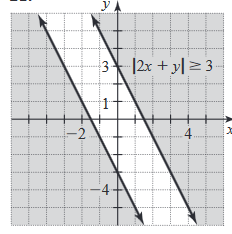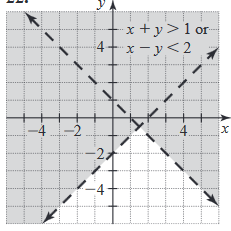|
Accounting | Business | Computer Science | General Studies | Math | Sciences | Civics Exam | Help/Support | Join/Cancel | Contact Us | Login/Log Out Intermediate
Algebra Chapter 1 2 3 4 5 6 7 8 9 10 11
Elementary and Intermediate Algebra Chapter 8: More on Inequalities
These Study Guides Are 100% Free
 Donate Please (Help keep it free)! This course is 100% Free. If you need more help with your class, I suggest Joining Now!
Write an
inequality that describes the graph below.
 -3 < x ≤ 2 No explanation needed. The graph starts at “(-3“ and ends at “2]”. Write an inequality that describes the graph below.  x > 1 No explanation needed. The graph starts at “1“ and continues in the positive direction indefinitely. Write the solution set for the following inequality using interval notation. x ≥ 3 [3, ∞) Interval Notation: Solve for x This means 3 is equal to x, and ∞ means all the numbers are greater than 3 indefinitely. Write the solution set for the following inequality using interval notation. x > 1 and x ≤ 6 (1, 6] No explanation needed. Interval Notation is written like so: (1,6] Write the solution set for the following inequality using interval notation. x < 5 and x > 9 (∞, 5) U (9, ∞) No explanation needed. Interval Notation is written like so: (∞, 5) U (9, ∞) Write the solution set for the following inequality using interval notation. |x| < 3 (-3, 3) To find the interval for the first piece, find where the inside of the absolute value is non-negative. x ≥ 0 In the piece where x is non-negative, remove the absolute value. x < 3 To find the interval for the second piece, find where the inside of the absolute value is negative. X < 0 In the piece where x is negative, remove the absolute value and multiply by −1. −x < 3 Write as a piecewise. {x < 3x ≥ 0 – x < 3x < 0 Find the intersection of x < 3 and x ≥ 0. 0 ≤ x < 3 Solve −x < 3 when x < 0. Divide each term in −x < 3 by −1 and simplify. X > −3 Find the intersection of x > −3 and x<0. −3 < x < 0 Find the union of the solutions. −3<x<3 The result can be shown in multiple forms. Inequality Form: −3 < x < 3 Interval Notation: (−3, 3) Write the solution set for the following inequality using interval notation. |x| ≥ 2 (-∞, -2) U (2, ∞) Write |x| ≥ 2 as a piecewise. To find the interval for the first piece, find where the inside of the absolute value is non-negative. X ≥ 0 In the piece where x is non-negative, remove the absolute value. X ≥ 2 To find the interval for the second piece, find where the inside of the absolute value is negative. X < 0 In the piece where x is negative, remove the absolute value and multiply by −1. −x ≥ 2 Write as a piecewise. {x ≥ 2x ≥ 0 – x ≥ 2x < 0 Find the intersection of x ≥ 2 and x ≥ 0. X ≥ 2 Divide each term in −x ≥ 2 by −1 and simplify. X ≤ −2 Find the union of the solutions. X ≤ −2 or x ≥ 2 Convert the inequality to interval notation. (−∞,−2]∪[2,∞) Solve the inequality. State the solution set using interval notation and graph the solution set. 2 x + 3 > 1 (-1, ∞) Move all terms not containing x to the right side of the inequality. Subtract 3 from both sides of the inequality. 2x > 1 −3 Subtract 3 from 1. 2x > −2 Divide each term in 2x > −2 by 2 and simplify. Divide each term in 2x > −2 by 2. 2x/2 > −2/2 x > −2/2 Simplify the right side. Divide −2 by 2 x > −1 The result can be shown in multiple forms. Inequality Form: X > −1 Interval Notation: (−1, ∞) Solve the inequality. State the solution set using interval notation and graph the solution set. |m – 6|≤ 2 [4, 8] Write |m − 6| ≤ 2 as a piecewise. {m – 6 ≤ 2m ≥ 6 – m + 6 ≤ 2m < 6 Solve m − 6 ≤2 when m ≥ 6 6 ≤ m ≤ 8 Solve −m + 6 ≤ 2 when m<6 4 ≤ m < 6 Find the union of the solutions. 4 ≤ m ≤ 8 The result can be shown in multiple forms. Inequality Form: 4 ≤ m ≤ 8 Interval Notation: [4,8] Solve the inequality. State the solution set using interval notation and graph the solution set. 2| x – 3| - 5 > 15 (-∞, -7) U (13, ∞) Write 2|x − 3| − 5 > 15 as a piecewise. {2x – 11 > 15x ≥ 3 − 2x + 1 > 15x < 3 Solve 2x – 11 > 15 for x. X > 13 Solve −2x+1>15 for x. X < −7 Find the union of the solutions. X < −7 or x > 13 The result can be shown in multiple forms. Inequality Form: x < −7 or x > 13 Interval Notation: (−∞, −7) ∪ (13, ∞) Solve the inequality. State the solution set using interval notation and graph the solution set. 2 – 3(w – 1) < -2w (5, ∞) Simplify 2−3(w−1). −3w + 5 < −2w Move all terms containing w to the left side of the inequality. −w + 5 < 0 Subtract 5 from both sides of the inequality. −w < −5 Divide each term in −w < −5 by −1 and simplify. W > 5 The result can be shown in multiple forms. Inequality Form: w > 5 Interval Notation: (5, ∞) Solve the inequality. State the solution set using interval notation and graph the solution set. 3x – 2 < 7 and -3x ≤ 15  Simplify the first inequality. x < 3 and −3x ≤ 15 Divide each term in −3x ≤ 15 by −3 and simplify. x < 3 and x ≥ −5 The intersection consists of the elements that are contained in both intervals. −5 ≤ x < 3 The result can be shown in multiple forms. Inequality Form: −5 ≤ x < 3 Interval Notation: [−5,3) Solve the inequality. State the solution set using interval notation and graph the solution set  Solve the equation or inequality. | 2x – 7 | = -3 Ø Solve the equation or inequality. x – 4 > 1 or x < 12 (-∞, ∞) Move all terms not containing x to the right side of the inequality. Add 4 to both sides of the inequality. X > 1 + 4 or x < 12 Add 1 and 4. X > 5 or x < 12 The union consists of all the elements that are contained in each interval. The result can be shown in multiple forms. All real numbers: Interval Notation: (-∞, ∞)
Solve the equation or inequality.
3x < 0 and x – 5 > 2 Ø Divide each term in 3 x < 0 by 3 and simplify. X < 0 and x – 5 > 2 Move all terms not containing x to the right side of the inequality. x < 0 and x > 7 The intersection consists of the elements that are contained in both intervals. No solution Solve the equation or inequality. | 2x – 5 | ≤ 0 {2.5} Write |2x−5| ≤ 0 as a piecewise. {2x – 5 ≤ 0 x ≥ −2x + 5 ≤ 0x < Solve 2x – 5 ≤ 0 when x ≥ x= Solve −2x + 5 ≤ 0 when x < No solution Find the union of the solutions. x = The result can be shown in multiple forms. Exact Form: x = Decimal Form: x = 2.5 Solve the equation or inequality. | x – 3 | < 0 Ø To find the interval for the first piece, find where the inside of the absolute value is non-negative. X – 3 ≥ 0 Add 3 to both sides of the inequality. x ≥ 3 In the piece where x−3 is non-negative, remove the absolute value. x − 3 < 0 Add 3 to both sides of the inequality. X < 3 In the piece where x−3 is negative, remove the absolute value and multiply by −1. −(x − 3) < 0 Write as a piecewise. {x – 3 < 0x ≥ 3 − (x−3) < 0x < 3 Simplify −(x − 3) < 0. {x – 3 < 0x ≥ 3 – x + 3 < 0x < 3 Solve x – 3 < 0 when x ≥ 3. Solve −x + 3 <0 when x < 3 No solution Solve the equation or inequality. | x – 6 | > -6 (-∞, ∞) Since |x−6| is always positive and −6 is negative, |x − 6| is always greater than −6 so the inequality is always true. All real numbers The result can be shown in multiple forms. All real numbers Interval Notation: (−∞,∞)
Sketch
the graph of the inequality x > 2 and x + y > 0.
Graph x > 2. Graph x + y > 0. Find the values of m and b using the
form y = mx + b. The slope of the line is the value
of m, and the y-intercept is the value of b. Graph a dashed line, then shade the
area above the boundary line since y is greater than −x. Plot each graph on the same coordinate
system. x + y > 0
Sketch the graph of the inequality |2x
+ y| ≥ 3.
Sketch the graph of the inequality x +
y > 1 or x – y < 2.
Graph x + y > 1. Use the slope-intercept form to find
the slope and y-intercept. Graph a dashed line, Graph x – y < 2 - Write in y = mx + b form. Use the slope-intercept form to find
the slope and y-intercept. Graph a dashed line, Plot each graph on the same
coordinate system.
Al and Brenda do the same
job, but their annual salaries differ by more than $3000,
Brenda
makes more than $31,000 or less than $25,000.
|
| Home |
Accounting & Finance | Business |
Computer Science | General Studies | Math | Sciences |
Civics Exam |
Everything
Else |
Help & Support |
Join/Cancel |
Contact Us |
Login / Log Out |





